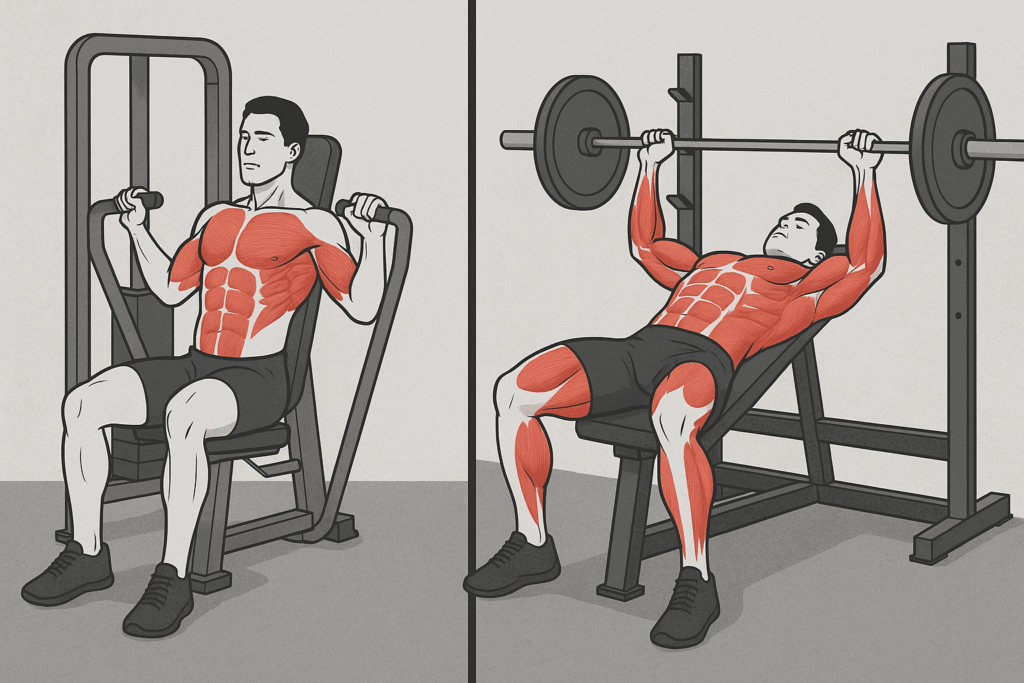Introduction: Why Barbell Training is the Foundation of Muscle Growth
Building muscle requires more than just lifting weights haphazardly or following random online workouts. For those seeking real strength gains and significant size increases, a structured approach is essential. One of the most effective ways to stimulate hypertrophy is through a strategically designed barbell hypertrophy program. This type of regimen leverages the compound efficiency and progressive overload of barbell exercises to drive maximal muscle growth. In this guide, we will explore the science, structure, and application of such a program, offering detailed insights for those ready to train with intention and intensity.
You may also like: The Ultimate Hypertrophy Workout Program for Building Strength and Size

Understanding Muscle Hypertrophy: The Foundation of Effective Training
Before diving into the specifics of a barbell hypertrophy program, it’s crucial to grasp what muscle hypertrophy truly entails. Muscle hypertrophy refers to the increase in muscle fiber size, and it occurs as a response to consistent resistance training, particularly when muscles are challenged with loads heavier than they are accustomed to. There are two primary types of hypertrophy: myofibrillar, which increases muscle strength and density, and sarcoplasmic, which enhances muscle volume through increased glycogen and fluid storage.
Hypertrophy training lies at the intersection of mechanical tension, muscle damage, and metabolic stress. Barbell training excels at promoting mechanical tension due to its potential for heavy, compound lifts that recruit multiple muscle groups. This not only stimulates growth in targeted muscles but also enhances systemic adaptations that support overall muscle development. By understanding these physiological underpinnings, athletes can tailor their routines to maximize hypertrophic outcomes.

Why a Barbell Hypertrophy Program Outperforms Generic Workouts
Many gym-goers fall into the trap of novelty-based training, constantly switching exercises or relying on machines that limit range of motion. A barbell hypertrophy program, in contrast, emphasizes consistency, progressive overload, and the use of compound movements that challenge the entire body. Barbell lifts such as the squat, deadlift, bench press, and overhead press activate large muscle groups and allow for incremental weight increases, which is essential for long-term muscle gain.
Unlike isolation-focused routines, barbell training induces a greater hormonal response, including spikes in testosterone and growth hormone levels, due to the high systemic demand. Moreover, barbell movements require stabilization and coordination, engaging core musculature and secondary stabilizers that might be neglected in machine-based workouts. This holistic engagement not only promotes hypertrophy but also functional strength, enhancing athletic performance and resilience.

Designing the Perfect Barbell Hypertrophy Program for Full-Body Gains
Crafting an effective full body hypertrophy workout using barbells begins with intelligent program design. A well-rounded barbell routine should prioritize compound lifts, incorporate varied rep ranges, and allow for adequate recovery. For beginners, three to four full-body sessions per week can yield substantial results. These sessions should center around fundamental barbell lifts, ensuring that all major muscle groups are stimulated frequently.
A typical full body hypertrophy workout might include squats, deadlifts, bench presses, rows, and overhead presses, performed in the 6-12 rep range with moderate to heavy loads. This rep range strikes a balance between mechanical tension and metabolic stress, both of which are critical for muscle growth. Additionally, incorporating tempo variations, rest-pause techniques, and drop sets can further enhance hypertrophic stimuli. By rotating training variables strategically, lifters can continue making gains while minimizing the risk of overtraining or plateauing.

The Science Behind Strength and Hypertrophy Program Design
Designing an optimal strength and hypertrophy program requires a careful balance between volume, intensity, and frequency. Volume refers to the total amount of work performed, typically measured as sets x reps x weight. Intensity refers to the load lifted, often expressed as a percentage of one’s one-rep max (1RM). Frequency denotes how often a muscle group is trained per week. For hypertrophy, moderate to high volume with moderate intensity and training each muscle group two to three times per week is generally most effective.
Periodization, or the planned manipulation of training variables over time, is a key component of an effective strength and hypertrophy program. Linear periodization gradually increases intensity while decreasing volume, whereas undulating periodization varies intensity and volume more frequently. Both methods can be effective when applied appropriately. Advanced lifters may benefit from block periodization, which segments training into specific blocks focusing on hypertrophy, strength, and peaking phases. This structured approach ensures continuous progression and reduces the risk of burnout.
Integrating a Strength and Hypertrophy Training Program into Your Routine
A successful strength and hypertrophy training program doesn’t exist in isolation; it must be integrated into a holistic lifestyle that includes proper nutrition, recovery, and mental focus. Nutritionally, sufficient protein intake is non-negotiable. Aim for 1.6 to 2.2 grams of protein per kilogram of body weight to support muscle repair and growth. Carbohydrates play a vital role as well, replenishing glycogen stores and fueling high-intensity training sessions.
Recovery is equally crucial. Muscles grow during rest, not during training. Ensuring 7-9 hours of quality sleep, practicing active recovery techniques, and incorporating rest days are essential components of any effective program. Additionally, tracking progress through a training journal or digital app can provide insights into performance trends and help identify areas for improvement. By aligning your lifestyle with your training goals, you create an environment conducive to hypertrophy and strength gains.

How a Barbell Hypertrophy Program Enhances Upper Body Development
Barbell training is exceptionally effective for building a powerful upper body. A focused upper body hypertrophy program utilizing barbell exercises targets major muscle groups such as the chest, back, shoulders, and arms with unparalleled efficiency. The bench press, for instance, is a staple for chest and triceps development, while bent-over rows and barbell curls effectively stimulate the lats and biceps.
An upper body hypertrophy program should include horizontal and vertical pushing and pulling movements to ensure balanced development. Incorporating variations such as incline bench presses, Pendlay rows, and overhead presses challenges muscles from different angles, leading to more comprehensive hypertrophy. The use of barbells also allows for progressive overload, a fundamental principle of muscle growth, which is often more difficult to apply with dumbbells or machines alone.
Moreover, focusing on barbell exercises for upper body hypertrophy promotes neurological efficiency. As the nervous system becomes more adept at recruiting motor units, strength gains accompany size increases. This dual adaptation not only contributes to aesthetic improvements but also enhances performance in sports and daily activities. By prioritizing barbell lifts, trainees can achieve a dense, muscular upper body that is both strong and functional.
The Importance of Progressive Overload in a Strength and Hypertrophy Program
Progressive overload is the cornerstone of any effective strength and hypertrophy training program. Without it, the body has no reason to adapt or grow stronger. This principle involves gradually increasing the demands placed on the muscles over time, whether through heavier weights, more reps, increased volume, or improved exercise technique. Barbell training lends itself particularly well to this concept, as it allows for small, measurable increases in load.
Tracking progress is essential for implementing progressive overload effectively. Lifters should aim to improve in some capacity each week, whether by adding five pounds to a lift, performing an extra rep, or reducing rest intervals. These incremental improvements signal the body to continue adapting, resulting in ongoing hypertrophy. It’s important, however, to balance overload with recovery. Overzealous increases in intensity or volume can lead to overtraining, injury, and stagnation.
Intelligent programming also involves deload weeks, during which volume and intensity are reduced to allow the body to recover fully. These scheduled breaks can prevent burnout and prepare the body for future gains. When progressive overload is applied thoughtfully within a structured barbell hypertrophy program, it becomes a powerful tool for sustainable muscle growth.

Maximizing Muscle Growth with a Full Body Hypertrophy Workout Structure
A full body hypertrophy workout offers several advantages, particularly for intermediate to advanced lifters looking to maximize training efficiency. This approach allows each muscle group to be trained multiple times per week, increasing the total volume and frequency of stimulation. Because barbell exercises engage large muscle groups, they are ideally suited for full-body routines that deliver a significant hypertrophic stimulus.
Designing a full body hypertrophy workout involves selecting compound barbell movements that cover the entire body. A typical session might include back squats for the lower body, bench presses for the chest, barbell rows for the back, and overhead presses for the shoulders. Accessory lifts, such as Romanian deadlifts and barbell curls, can be added to target specific areas while complementing the primary movements.
Rest periods between sets should be optimized based on training goals. For hypertrophy, rest intervals of 60-90 seconds are typically recommended to maintain muscular fatigue while allowing partial recovery. This strategy enhances metabolic stress and increases muscle fiber recruitment. Rotating between different exercise variations and rep schemes from session to session keeps the body adapting and prevents stagnation. When executed properly, full body hypertrophy workouts serve as a potent method for driving comprehensive muscle growth.
Targeting Specific Muscles with an Upper Body Hypertrophy Workout
While full-body routines offer comprehensive coverage, an upper body hypertrophy workout allows for more focused attention on upper musculature. This approach is especially beneficial for individuals seeking to enhance upper body aesthetics or correct imbalances. With barbell exercises, targeting specific upper body muscles becomes both efficient and effective due to the ability to apply significant load.
An upper body hypertrophy workout typically begins with a major pressing movement such as the flat or incline barbell bench press. This is followed by pulling movements like barbell rows or pull-ups. Shoulder development is addressed with overhead presses and lateral raises, while arms can be isolated with barbell curls and close-grip bench presses. Structuring the workout to alternate between push and pull movements ensures balanced fatigue and optimal performance across exercises.
Progress tracking is key to continued improvement. Lifters should log each workout to monitor increases in weight, reps, or exercise complexity. Additionally, incorporating techniques such as rest-pause sets or eccentric overload can amplify muscle breakdown and hypertrophic signaling. By emphasizing barbell lifts and prioritizing proper form and progression, upper body hypertrophy workouts become a reliable tool for building muscle size and symmetry.
Frequently Asked Questions: Advanced Insights for a Barbell Hypertrophy Program
How can I break through a plateau in my barbell hypertrophy program?
Plateaus are common in any long-term training regimen, especially in a barbell hypertrophy program where progressive overload is key. One effective method to break through stagnation is by temporarily altering training variables—such as switching to a higher frequency or incorporating novel barbell variations like pause squats or deficit deadlifts. Periodic deload weeks followed by volume ramp-ups can also resensitize the body to training stimuli. Additionally, reassessing recovery factors such as sleep quality, macronutrient distribution, and daily stress can reveal hidden barriers to growth. Sometimes, progress resumes not by adding more weight but by refining form, tempo, or mind-muscle connection during each repetition.
What role does intra-workout nutrition play in a strength and hypertrophy training program?
While much attention is paid to pre- and post-workout nutrition, intra-workout strategies can also enhance performance in a strength and hypertrophy training program. During longer sessions, consuming a carbohydrate-electrolyte solution can maintain glycogen availability and delay fatigue, helping you complete higher volume with better quality. Adding a small amount of branched-chain amino acids (BCAAs) may also help preserve muscle tissue during prolonged training, though whole protein sources still reign supreme. This is especially beneficial for those engaging in a full body hypertrophy workout where large muscle groups are trained over extended periods. Optimizing nutrient timing not only supports immediate energy needs but may also aid in quicker post-session recovery.
Is it effective to combine a barbell hypertrophy program with cardio?
Contrary to the fear of muscle loss, combining a barbell hypertrophy program with well-structured cardiovascular training can improve recovery, metabolic flexibility, and overall work capacity. Low- to moderate-intensity steady-state cardio, performed on non-lifting days or after hypertrophy sessions, supports circulation and aids nutrient delivery. High-intensity interval training (HIIT), if used sparingly, can improve anaerobic endurance and complement compound barbell lifts by enhancing ATP efficiency. The key is timing and volume—cardio should never interfere with recovery from your main strength and hypertrophy program. In fact, many athletes find that strategic cardio improves their performance in upper body hypertrophy workouts by reducing overall systemic fatigue.
How does a full body hypertrophy workout benefit hormonal health?
Engaging in a full body hypertrophy workout stimulates large muscle groups simultaneously, which leads to increased secretion of anabolic hormones such as testosterone and growth hormone. These hormonal surges are particularly valuable for muscle growth, fat metabolism, and even mood regulation. Moreover, total-body sessions place a systemic demand on the body, reinforcing hormonal signaling cascades that support tissue repair and protein synthesis. This is one reason why full body training routines are often recommended to older adults seeking to preserve lean mass and hormonal balance. When paired with a nutrient-rich diet and sufficient sleep, full body hypertrophy workouts can be a powerful tool for optimizing both physical and metabolic health.
What are the best strategies for recovery in an upper body hypertrophy program?
Recovery in an upper body hypertrophy program goes beyond just rest days—it involves strategic interventions that promote tissue healing, inflammation control, and nervous system reset. Techniques such as contrast therapy (alternating heat and cold), myofascial release using foam rollers, and dynamic stretching can accelerate localized recovery in heavily trained regions like the chest and shoulders. Including omega-3 fatty acids in your diet may help reduce muscle soreness, while sleep tracking apps can help optimize nighttime recovery cycles. For those training upper body more than twice per week, adjusting exercise selection to alternate between heavy and moderate sessions ensures cumulative fatigue doesn’t outpace recovery capacity. This tailored recovery plan is especially vital for lifters using progressive overload in barbell movements where joint stress can accumulate quickly.
How can psychological strategies improve adherence to a strength and hypertrophy program?
Success in any strength and hypertrophy program depends heavily on long-term adherence, and psychology plays a central role in maintaining consistency. Establishing concrete performance goals, such as achieving a specific 5-rep max on a compound lift, can provide daily motivation. Journaling progress, celebrating small victories, and using visualization techniques to rehearse lifts enhance focus and reduce performance anxiety. Social accountability, such as training with a partner or coach, increases both commitment and effort. Incorporating mental resilience training—like box breathing or meditation—can also help manage the emotional highs and lows that accompany intense upper body hypertrophy workouts and extended training cycles.
Can a barbell hypertrophy program be adapted for home gyms with limited equipment?
Absolutely. A barbell hypertrophy program can be highly adaptable for home gym setups, even with minimal equipment. By focusing on a few key lifts such as barbell back squats, deadlifts, floor presses, and bent-over rows, individuals can build a highly effective full body hypertrophy workout without needing machines or cable stacks. Adjustable squat racks, a sturdy bench, and a quality barbell with plates are the primary investments. Unilateral variations and tempo training can help compensate for lighter loads, offering sufficient muscular tension for growth. Creative loading strategies—like cluster sets or time-under-tension methods—can further expand the program’s effectiveness in a constrained environment.
What are emerging trends in strength and hypertrophy training program design?
The evolution of the strength and hypertrophy training program is increasingly influenced by digital tools, individualized data tracking, and recovery technologies. Wearable devices now provide real-time feedback on heart rate variability, muscular fatigue, and training readiness, allowing for more precise load management. AI-driven apps can adjust workouts based on performance trends, ensuring continuous progression without overtraining. Blood flow restriction (BFR) training is another emerging technique used during deloads or rehab phases, particularly effective when incorporated into upper body hypertrophy workouts. Biomechanical screening is gaining traction as a method for customizing movement patterns and injury prevention protocols. These innovations allow lifters to fine-tune their routines in ways that were once reserved for elite athletes.
What considerations should women have when following a full body hypertrophy workout?
Women can benefit immensely from a full body hypertrophy workout, though some considerations may help optimize results. Due to hormonal differences, women often recover faster from training and may benefit from higher training frequencies or more volume per session. Exercises that emphasize glutes, hamstrings, and posterior deltoids can align with common physique goals, while maintaining balance in chest and arm development remains essential. Tracking menstrual cycle phases can also guide intensity adjustments, as strength may peak during certain weeks while fatigue tolerance varies. Finally, women should feel empowered to pursue progressive overload without fear of “bulking”—muscle growth is a slow and controlled process and foundational to a lean, athletic physique.
How can you periodize an upper body hypertrophy workout for long-term progress?
Periodizing an upper body hypertrophy workout allows for strategic variation over weeks and months to avoid stagnation and burnout. One method involves cycling through mesocycles focused on different objectives: hypertrophy (8–12 reps), strength (4–6 reps), and muscular endurance (12–15+ reps). Deliberately varying rest periods, tempo, and lift variations prevents mental and physical fatigue. For example, one block might prioritize the incline bench press and barbell row, while the next focuses on overhead pressing and weighted chin-ups. Including a low-volume transition phase every 8–10 weeks can also enhance recovery and mental freshness before entering another growth-oriented cycle. This structured approach ensures that your upper body hypertrophy program evolves with your body’s changing needs and capacities.
Conclusion: Embrace the Power of the Barbell for Lasting Muscle Gains
The journey to building muscle is a marathon, not a sprint. A proven barbell hypertrophy program offers a timeless and effective path to significant muscle development, improved strength, and enhanced performance. By leveraging compound lifts, applying progressive overload, and integrating smart periodization, lifters can experience lasting gains without unnecessary complexity. Whether you’re targeting full body hypertrophy, refining your upper body structure, or integrating a comprehensive strength and hypertrophy training program into your lifestyle, barbells provide the foundation for sustainable success.
Consistency, patience, and intelligent planning are your greatest allies. Pairing structured training with proper nutrition, recovery, and self-awareness ensures that your efforts yield real, lasting results. For those serious about strength and aesthetics, the barbell is more than a tool—it’s a catalyst for transformation. Embrace it, trust the process, and let your dedication carve out the physique and power you’ve always envisioned.
Further Reading:
4 Upper-Body Hypertrophy Workouts (11 Best Exercises)
Strength Training for Hypertrophy: Exercises & Cycles for Muscle Gain





